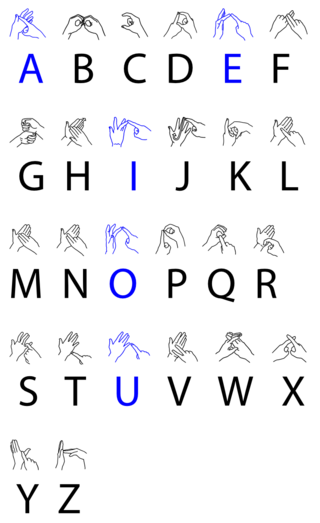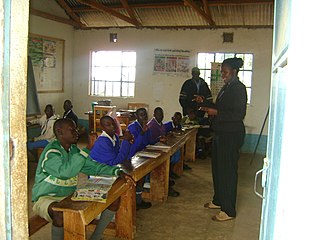Related Research Articles

Sign languages are languages that use the visual-manual modality to convey meaning, instead of spoken words. Sign languages are expressed through manual articulation in combination with non-manual markers. Sign languages are full-fledged natural languages with their own grammar and lexicon. Sign languages are not universal and are usually not mutually intelligible, although there are also similarities among different sign languages.

International Sign (IS) is a pidgin sign language which is used in a variety of different contexts, particularly as an international auxiliary language at meetings such as the World Federation of the Deaf (WFD) congress, in some European Union settings, and at some UN conferences, at events such as the Deaflympics, the Miss & Mister Deaf World, and Eurovision, and informally when travelling and socialising.

British Sign Language (BSL) is a sign language used in the United Kingdom and is the first or preferred language among the deaf community in the UK. Based on the percentage of people who reported 'using British Sign Language at home' on the 2011 Scottish Census, the British Deaf Association estimates there are 151,000 BSL users in the UK, of whom 87,000 are Deaf. By contrast, in the 2011 England and Wales Census 15,000 people living in England and Wales reported themselves using BSL as their main language. People who are not deaf may also use BSL, as hearing relatives of deaf people, sign language interpreters or as a result of other contact with the British Deaf community. The language makes use of space and involves movement of the hands, body, face and head.
Auslan is the sign language used by the majority of the Australian Deaf community. The term Auslan is a portmanteau of "Australian Sign Language", coined by Trevor Johnston in the 1980s, although the language itself is much older. Auslan is related to British Sign Language (BSL) and New Zealand Sign Language (NZSL); the three have descended from the same parent language, and together comprise the BANZSL language family. Auslan has also been influenced by Irish Sign Language (ISL) and more recently has borrowed signs from American Sign Language (ASL).
Interpreting is a translational activity in which one produces a first and final target-language output on the basis of a one-time exposure to an expression in a source language.

New Zealand Sign Language or NZSL is the main language of the deaf community in New Zealand. It became an official language of New Zealand in April 2006 under the New Zealand Sign Language Act 2006. The purpose of the act was to create rights and obligations in the use of NZSL throughout the legal system and to ensure that the Deaf community had the same access to government information and services as everybody else. According to the 2013 Census, over 20,000 New Zealanders know NZSL.
Dorothy "Dot" Miles was a Welsh poet and activist in the deaf community. Throughout her life, she composed her poems in English, British Sign Language, and American Sign Language. Her work laid the foundations for modern sign language poetry in the United States and the United Kingdom. She is regarded as the pioneer of BSL poetry and her work influenced many contemporary Deaf poets.
Manually Coded English (MCE) is a type of sign system that follows direct spoken English. The different codes of MCE vary in the levels of directness in following spoken English grammar. There may also be a combination with other visual clues, such as body language. MCE is typically used in conjunction with direct spoken English.

South African Sign Language is the primary sign language used by deaf people in South Africa. The South African government added a National Language Unit for South African Sign Language in 2001. SASL is not the only manual language used in South Africa, but it is the language that is being promoted as the language to be used by the Deaf in South Africa, although Deaf peoples in South Africa historically do not form a single group.

Stokoe notation is the first phonemic script used for sign languages. It was created by William Stokoe for American Sign Language (ASL), with Latin letters and numerals used for the shapes they have in fingerspelling, and iconic glyphs to transcribe the position, movement, and orientation of the hands. It was first published as the organizing principle of Sign Language Structure: An Outline of the Visual Communication Systems of the American Deaf (1960), and later also used in A Dictionary of American Sign Language on Linguistic Principles, by Stokoe, Casterline, and Croneberg (1965). In the 1965 dictionary, signs are themselves arranged alphabetically, according to their Stokoe transcription, rather than being ordered by their English glosses as in other sign-language dictionaries. This made it the only ASL dictionary where the reader could look up a sign without first knowing how to translate it into English. The Stokoe notation was later adapted to British Sign Language (BSL) in Kyle et al. (1985) and to Australian Aboriginal sign languages in Kendon (1988). In each case the researchers modified the alphabet to accommodate phonemes not found in ASL.
Clive Mason is a Deaf Scottish television presenter and actor.
The Centre for Deaf Studies is part of the School of Linguistic, Speech and Communication Sciences, Trinity College Dublin and is the only university offering Deaf Studies related courses on the island of Ireland.

Deaf education is the education of students with any degree of hearing loss or deafness. This may involve, but does not always, individually-planned, systematically-monitored teaching methods, adaptive materials, accessible settings, and other interventions designed to help students achieve a higher level of self-sufficiency and success in the school and community than they would achieve with a typical classroom education. There are different language modalities used in educational setting where students get varied communication methods. A number of countries focus on training teachers to teach deaf students with a variety of approaches and have organizations to aid deaf students.
The Centre for Deaf Studies was a department of the University of Bristol, England, in the field of deaf studies, which it defines as the study of the "language, community and culture of Deaf people". Established in 1978, the Centre claimed to be the first higher educational Institute in Europe "to concentrate solely on research and education that aims to benefit the Deaf community". The centre was at the forefront in establishing the disciplines of deaf studies and deafhood. It used British Sign Language (BSL), had a policy of bilingual communication in BSL and English, and employed a majority of deaf teaching staff.

Paddy Ladd is an English deaf scholar, author, activist and researcher of deaf culture. Ladd was a lecturer and MSc Coordinator at the Centre for Deaf Studies at the University of Bristol. Despite considerable international pressure, the centre was wound down as the MSc was closed in 2009, the undergrad programme taught out from 2010 to 2013, and the centre finally closed in the July of that year.
Deaf Education in Kenya is a constantly changing section of the Kenyan education system that is focused on educating deaf, hard-of-hearing, and hearing-impaired Kenyan students. There are many organizations in Kenya made to protect the rights of Deaf Kenyans and promote progress in deaf education. The state of Kenyan deaf education is constantly changing and improving.
Bencie Woll FAAAS is an American–British linguist and scholar of sign language. She became the first professor of sign language in the United Kingdom when she was appointed Professor of Sign Language and Deaf Studies at City University, London in 1995. In 2005, she moved to University College London where she became Professor of Sign Language and Deaf Studies and Director of the Deafness, Cognition and Language Research Centre (DCAL).

Audrey Cameron is a Chancellor's Fellow working at the University of Edinburgh. She is Deaf and uses British Sign Language.
Clark Denmark is a British activist, lecturer and interpreter. He is deaf and a British Sign Language (BSL) user, and he is widely recognised within the Deaf community for his role in advancing the recognition and wider understanding of BSL.
Cathy Heffernan is an Irish freelance journalist, documentarist and producer living in England. She is deaf and a British Sign Language user as well as her native Irish Sign Language.
References
- ↑ Brien, David; Brennan, Mary, eds. (1993). Dictionary of British Sign Language. Durham: Faber & Faber. ISBN 0571143466.
- ↑ "First user of British Sign Language on university academic planning body". Durham University. 8 March 2005. Archived from the original on 11 January 2021.
- ↑ Collins, Judith; Walker, John (2006). Rachel McKee (ed.). "What is a Deaf Interpreter?". Proceedings of the Inaugural Conference of the World Association of Sign Language Interpreters: 79–90.
- ↑ Collins, Judith; Tate, Granville; Hann, Paul (2012). "A Translation Studies Approach to Glossing Using ELAN". International Journal of Interpreter Education. 4 (1): 83–91.
- ↑ "I am very pleased BSL is visible in a senate chamber in the UK". Times Higher Education. 11 March 2005.
- ↑ "Under the Lamp 1: Programme 6 on BSL Zone".
- ↑ "Judith Tate-Collins". Durham University. 18 July 2014. Archived from the original on 11 January 2021.